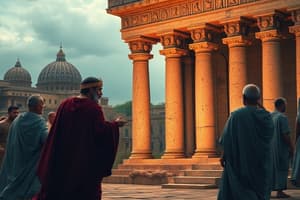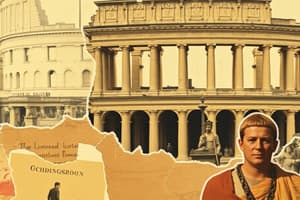Podcast
Questions and Answers
Which factor most directly contributed to the economic decline of the Western Roman Empire?
Which factor most directly contributed to the economic decline of the Western Roman Empire?
- Increased investment in public infrastructure projects.
- Reduced military spending and a focus on trade.
- Heavy taxation of the lower classes coupled with tax evasion by the wealthy. (correct)
- Successful implementation of sustainable agricultural practices using slave labor.
How did the 'barbarization' of the Roman army contribute to the empire's decline?
How did the 'barbarization' of the Roman army contribute to the empire's decline?
- It resulted in divided loyalties among the troops and a decline in military effectiveness. (correct)
- It encouraged technological advancements in Roman weaponry.
- It led to increased loyalty and efficiency within the military ranks.
- It decreased the overall cost of maintaining a large army.
Why was the Eastern Roman (Byzantine) Empire able to survive while the West collapsed?
Why was the Eastern Roman (Byzantine) Empire able to survive while the West collapsed?
- The East had a unified religious system that prevented internal conflict.
- The East was wealthier, more urbanized, and had better defenses. (correct)
- The East embraced a completely isolationist policy, avoiding external conflicts.
- The East had a weaker military, so it was less likely to be targeted.
What was the long-term impact of the Treaty of Verdun (843) on the Carolingian Empire?
What was the long-term impact of the Treaty of Verdun (843) on the Carolingian Empire?
How did the Carolingian Renaissance influence European culture?
How did the Carolingian Renaissance influence European culture?
What was the significance of the Battle of Tours (732) in European history?
What was the significance of the Battle of Tours (732) in European history?
How did the Devshirme system function within the Ottoman Empire?
How did the Devshirme system function within the Ottoman Empire?
Why was the capture of Constantinople (1453) by Mehmed II a turning point?
Why was the capture of Constantinople (1453) by Mehmed II a turning point?
What was the impact of Suleiman the Magnificent's reign on the Ottoman Empire?
What was the impact of Suleiman the Magnificent's reign on the Ottoman Empire?
Which of the following factors contributed to the decline of the Ottoman Empire?
Which of the following factors contributed to the decline of the Ottoman Empire?
How did the rise of Christianity impact the Western Roman Empire?
How did the rise of Christianity impact the Western Roman Empire?
How did the actions of the Praetorian Guard contribute to the political instability of the Western Roman Empire?
How did the actions of the Praetorian Guard contribute to the political instability of the Western Roman Empire?
What role did the Huns play in the barbarian invasions of the Western Roman Empire?
What role did the Huns play in the barbarian invasions of the Western Roman Empire?
How did Charlemagne attempt to revive the Western Roman Empire?
How did Charlemagne attempt to revive the Western Roman Empire?
What measures did Charlemagne take to ensure effective governance of his large empire?
What measures did Charlemagne take to ensure effective governance of his large empire?
Why was the Battle of Lepanto (1571) a significant event in the history of the Ottoman Empire?
Why was the Battle of Lepanto (1571) a significant event in the history of the Ottoman Empire?
What was the function of the Millet system in the Ottoman Empire?
What was the function of the Millet system in the Ottoman Empire?
What was a key difference between the structure of the Carolingian Empire and the later Ottoman Empire?
What was a key difference between the structure of the Carolingian Empire and the later Ottoman Empire?
Why did reliance on slave labor ultimately harm the economy of the Western Roman Empire?
Why did reliance on slave labor ultimately harm the economy of the Western Roman Empire?
How did debasement of currency impact the Western Roman Empire?
How did debasement of currency impact the Western Roman Empire?
Flashcards
Political Instability
Political Instability
Frequent civil wars and power struggles that weakened the empire.
Economic Decline
Economic Decline
Heavy taxation, inflation and trade decline.
Military Weakness
Military Weakness
Army dependent on foreign mercenaries and overextension.
Barbarian Invasions
Barbarian Invasions
Signup and view all the flashcards
Social & Cultural Changes
Social & Cultural Changes
Signup and view all the flashcards
Eastern Roman Empire
Eastern Roman Empire
Signup and view all the flashcards
Battle of Tours
Battle of Tours
Signup and view all the flashcards
Pope Leo III
Pope Leo III
Signup and view all the flashcards
Feudal System
Feudal System
Signup and view all the flashcards
Missi Dominici
Missi Dominici
Signup and view all the flashcards
Carolingian Renaissance
Carolingian Renaissance
Signup and view all the flashcards
Treaty of Verdun
Treaty of Verdun
Signup and view all the flashcards
Ottoman Empire Foundation
Ottoman Empire Foundation
Signup and view all the flashcards
Mehmed II
Mehmed II
Signup and view all the flashcards
Suleiman the Magnificent
Suleiman the Magnificent
Signup and view all the flashcards
Devshirme System
Devshirme System
Signup and view all the flashcards
Millet System
Millet System
Signup and view all the flashcards
Janissaries
Janissaries
Signup and view all the flashcards
Kanun Laws
Kanun Laws
Signup and view all the flashcards
Dissolution of Ottoman Empire
Dissolution of Ottoman Empire
Signup and view all the flashcards
Study Notes
The Fall of the Western Roman Empire (476 AD)
- The fall resulted from long-term internal weaknesses and external pressures.
- Political instability, economic decline, military weakness, barbarian invasions, and social changes were all contributing factors.
Political Instability & Weak Leadership
- Frequent civil wars and power struggles destabilized the empire.
- The Praetorian Guard often assassinated or overthrew emperors.
- The division of the empire in 395 AD reduced coordination between East and West.
- Many emperors were ineffective, resulting in poor governance.
Economic Decline & Overreliance on Slavery
- Heavy taxation burdened the lower classes, while the rich avoided taxes.
- Inflation occurred due to debasing the currency.
- Trade and agriculture declined as slave labor became less sustainable.
- Urban decay occurred as cities shrank and infrastructure deteriorated.
Military Weakness & Overextension
- The army became dependent on foreign mercenaries (foederati).
- Barbarization of the army led to divided loyalties.
- The empire was too large to defend effectively.
- The Battle of Adrianople (378 AD) against the Goths significantly weakened the military.
Barbarian Invasions & Migrations
- Goths (Visigoths & Ostrogoths) fled into Roman territory due to Hunnic pressure.
- The Sack of Rome (410 AD) by Alaric the Visigoth shocked the empire.
- Vandals invaded Gaul, Spain, and North Africa, sacking Rome in 455 AD.
- The Huns under Attila (434–453 AD) ravaged the Balkans and Italy.
- In 476 AD, Odoacer deposed Romulus Augustulus, the last Western Roman emperor.
Social & Cultural Changes
- Civic patriotism declined.
- Christianity’s rise shifted focus from the state to religion.
- A cultural divide between the Latin West and Greek East emerged.
The Eastern Empire’s Survival
- The Eastern Roman (Byzantine) Empire survived due to wealth, urbanization, and better defenses.
- The West lacked these advantages and collapsed first.
- No single factor caused the fall; it was a slow decline.
The Carolingian Empire (800–888 AD)
- The empire emerged from the Frankish Kingdom.
- Charles Martel halted the Muslim advance at the Battle of Tours (732).
- Pepin the Short became the first Carolingian king (751–768).
- Charlemagne expanded the empire into Italy, Germany, and Spain.
Charlemagne's Rule
- In 800 AD, Pope Leo III crowned Charlemagne "Emperor of the Romans."
Government & Administration
- It used a feudal system.
- Missi Dominici monitored regional administration.
- Capitularies were issued to standardize governance.
Military & Expansion
- Armored cavalry (knights) and Frankish infantry were heavily relied on.
- It conquered Lombardy, Saxony, and parts of Spain.
- There were battles against Saxons, Avars, and Muslims.
Culture & Legacy
- The Carolingian Renaissance saw a revival of Latin learning, art, and architecture.
- Christianity spread through forced conversions.
Division of the Empire
- The Treaty of Verdun (843) split the empire among Charlemagne’s grandsons.
- This division led to the foundations of France, Germany, and Italy.
Decline
- Weak successors and Viking invasions weakened central authority.
- By 888 AD, the empire fragmented into smaller feudal states.
The Ottoman Empire (1299–1922 AD)
- Osman I founded it in 1299.
- It was initially a small Turkish beylik in Anatolia.
- It expanded under Murad I and Bayezid I into the Balkans.
- Mehmed II captured Constantinople (1453).
- Suleiman the Magnificent brought the empire to its peak (1520–1566).
Government & Administration
- The Sultan was the absolute ruler.
- The Grand Vizier advised the Sultan.
- The Devshirme system was used.
- The Millet system was used.
Military & Expansion
- Janissaries were an elite infantry corps.
- The navy dominated the Mediterranean.
- Egypt was conquered in 1517.
- Hungary was conquered in 1526.
Culture & Legacy
- Islamic art & architecture flourished
- There was tolerance of religious minorities.
- Legal reforms were implemented.
Decline
- There was a loss at the Battle of Lepanto (1571).
- The Siege of Vienna failed in 1683.
- Economic stagnation took place.
- European powers outpaced its industrialization.
- It was dissolved after WWI (1922).
- The Republic of Turkey under Mustafa Kemal Atatürk replaced it.
Studying That Suits You
Use AI to generate personalized quizzes and flashcards to suit your learning preferences.




